Breath of confidence at Scottish Show
Page 19
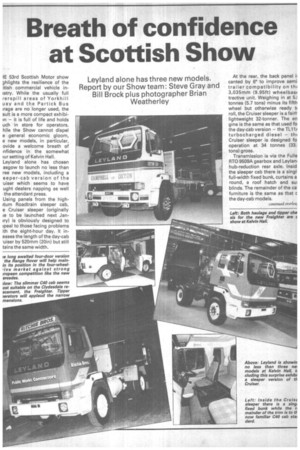
Page 21
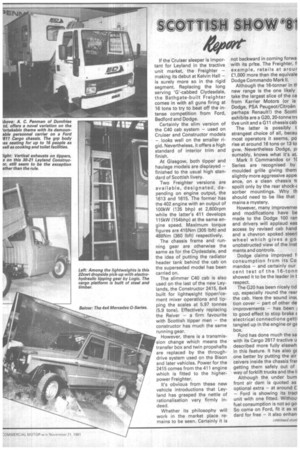
Page 23
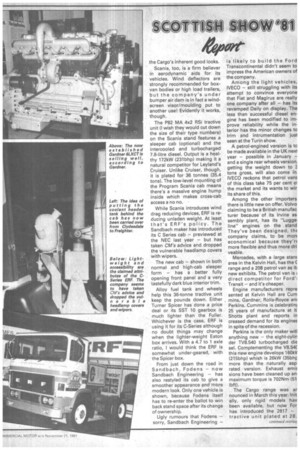
Page 25
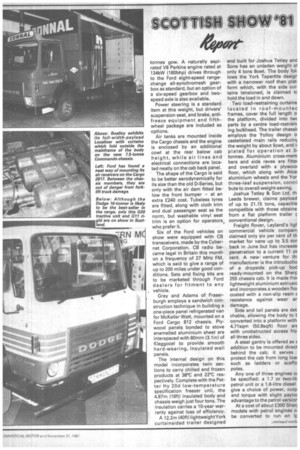
Page 26
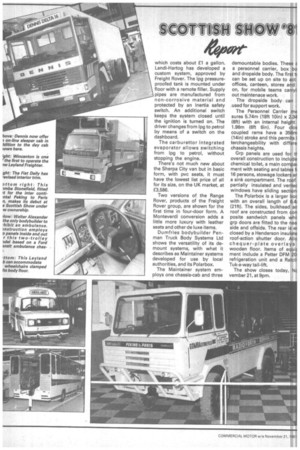
If you've noticed an error in this article please click here to report it so we can fix it.
Leyland alone has three new models. Report by our Show team: Steve Gray and Bill Brock plus photographer Brian Weatherley
1 E 53rd Scottish Motor show ghlights the resilience of the itish commercial vehicle inistry. While the usually full ferspill areas of Yorkhill uayand the Partick Bus rage are no longer used, the suit is a more compact exhibi
it is full of life and holds uch in store for operators. hile the Show cannot dispel e general economic gloom, e new models, in particular, ovide a welcome breath of nfidence in the somewhat iur setting of Kelvin Hall.
Leyland alone has chosen asgow to launch no less than ree new models, including a eeper-cab version of the uiser which seems to have ught dealers napping as well the attendant press.
Using panels from the highturn Roadtrain sleeper cab,
e Cruiser sleeper (originally ie to be launched next Janiry) is obviously designed to )peal to those facing problems ith the eight-hour day. It ineases the length of the day-cab .uiser by 520mm (20in) but still tains the same width. At the rear, the back panel canted by 60 to improve semi trailer compatibility on thi 3,035mm (9.95ft) wheelbasi tractive unit. Weighing in at 5.1 tonnes (5.7 tons) minus its fifth wheel but otherwise ready ti roll, the Cruiser sleeper is a Mitt lightweight 32-tonner. The en gine is the same as that used fo the day-cab version — the -11_11,1 turbocharged diesel — thi Cruiser sleeper is designed fo operation at 34 tonnes (33. tons) gross.
Transmission is via the Fulle RTO 9509A gearbox and Leylani hub-reduction rear axle. lnsid the sleeper cab there is a singl full-width fixed bunk, curtains a round, a roof hatch and sui blinds. The remainder of the ca furniture is the same as that c the day-cab models. If the Cruiser sleeper is important for Leyland in the tractive unit market, the Freighter — making its debut at Kelvin Hall — is surely more so in the rigid segment. Replacing the long serving 'G'-cabbed Clydesdale, the Bathgate-built Freighter comes in with all guns firing at 16 tons to try to beat off the intense competition from Ford, Bedford and Dodge.
Certainly the slim version of the C40 cab system — used on Cruiser and Constructor models — looks well on the smaller rigid. Nevertheless, it offers a high standard of interior trim and finish.
At Glasgow, both tipper and haulage models are displayed — finished to the usual high standard of Scottish livery.
Two Freighter versions are available, designated, depending on engine output, the 1613 and 1615. The former has the 402 engine with an output of 100kW (135 bhp) at 2,600rpm while the latter's 411 develops 115kW (154bhp) at the same engine speed. Maximum torque figures are 415Nm (305 Ibft) and 488Nm (360 lbft) respectively.
The chassis frame and running gear are otherwise the same as for the Clydesdale, and the idea of putting the radiator header tank behind the cab on the superseded model has been carried on.
The slimmer C40 cab is also used on the last of the new Leylands, the Constructor 2415, 6x4 built for lightweight tipper/cement mixer operations and tipping the scales at 5.97 tonnes (5.9 tons). Effectively replacing the Reiver — a firm favourite with Scottish tipper men — the constructor has much the same running gear.
However, there is a transmission change which means the transfer box and twin propshafts are replaced by the throughdrive system used on the Bison and later vehicles. Power for the 2415 comes from the 411 engine which is fitted to the higherpower Freighter.
It's obvious from these new vehicle introductions that Leyland has grasped the nettle of rationalisation very firmly indeed.
Whether its philosophy will work in the market place remains to be seen. Certainly it is
not backward in coming forwa with its price. The Freighter, f, example, retails at arour £1,000 more than the equivale Dodge Commando Mark II.
Although the 16-tonner in tlnew range is the one likely take the largest slice of the ca from Karrier Motors (or is Dodge, PSA Peugeot/Citroen perhaps Renault!) the Scott] exhibits are a G20, 20-tonne tre tive unit and a G11 chassis cab
The latter is possibly t strangest choice of all, becau most operators it seems, po rise at around 16 tons or 13 to gvw. Nevertheless Dodge, pi surnably, knows what it's at.
Mark II Commandos or 1( Series are recognised by moulded grille giving them slightly more aggressive appe. ance, on a clean chassis tc spoilt only by the rear shock-e sorber mountings. Why th should need to be like that mains a mystery.
However, many improvemer and modifications have be made to the Dodge 100 ran and drivers will applaud eas access by revised cab hand and a chevron spoked steer wheel which gives a go unobstructed view of the inst ments and controls.
Dodge claims improved fi consumption from its Co mandos — and certainly our cent test of the 1 6-tonn showed it to be the leader in t respect.
The G20 has been nicely tid up, especially round the rear the cab. Here the sound ina tion cover — part of other de improvements — has been I to good effect to stop brake e electrical connections getti tangled up in the engine or gE box.
Ford has done much the sa with its Cargo 2817 tractive u described more fully elsewh in this feature. It has also gt one better by putting the air ceivers inside the chassis frar getting them safely out of way of forklift trucks and the Ii Although the under bum front air dam is quoted as optional extra — at around E — Ford is showing its traci unit with one fitted. Withoui
fuel consumption is not so go So come on Ford, fit it as St dard for free — it also enhan,
the Cargo's Cargo's inherent good looks.
Scania, too, is a firm believer in aerodynamic aids for its vehicles. Wind deflectors are strongly recommended for boxvan bodies or high load trailers, but the company's under bumper air dam is in fact a windscreen visor/moulding put to another use! Evidently it works, though.
The P82 MA 4x2 RSi tractive unit (I wish they would cut down the size of their type numbers) on the Scania stand features a sleeper cab (optional) and the intercooled and turbocharged 7.8-litre diesel. Output is a healthy 172kW (231bhp) making it a natural competitor for Leyland's Cruiser. Unlike Cruiser, though, it is plated for 36 tonnes (35.4 tons). The low-level mounting of the Program Scania cab means there's a massive engine hump inside which makes cross-cab access a no no.
While Scania introduces wind drag reducing devices, ERF is reducing unladen weight. At least that's ERF's policy. The Sandbach maker has introduced its C Series cab — previewed at the NEC last year — but has taken CM's advice and dropped the vulnerable headlamp covers with wipers.
The new cab — shown in both normal and high-cab sleeper form — has a better fully opening front panel and a very tastefully dark blue interior trim.
Alloy fuel tank and wheels help this 36-tonne tractive unit keep the pounds down. Either Turner Spicer has done a price deal or its SST 10 gearbox is much lighter than the Fuller. Whichever is the case, ERF is using it for its C-Series although no doubt things may change when the lighter-weight Eaton box arrives. With a 4.7 to 1 axle ratio, I would think the ERF is somewhat under-geared, with the Spicer box.
From just down the road in Sandbach, Fodens — now Sandbach Engineering — has also restyled its cab to give a smoother appearance and more modern look. Only one vehicle is shown, because Fodens itself has to re-enter the ballot to win back stand space after its change of ownership.
Ugly rumours that Fodens — sorry, Sandbach Engineering — is likely to build the Ford Transcontinental didn't seem to impress the American owners of the company.
Among the light vehicles, IVECO — still struggling with its attempt to convince everyone that Fiat and Magirus are really one company after all — has its revamped Daily on display. The less than successful diesel engine has been modified to improve reliability while the interior has the minor changes to trim and intrumentation just seen at the Turin show.
A petrol-engined version is to be made available in the UK next year — possible in January — and a single rear wheels version, getting the weight down to 2 tons gross, will also come in IVECO reckons that petrol vans of this class take 75 per cent 01 the market and its wants to wir its share of this.
Among the other importers there is little new on offer. Volvo claiming to be a British manufac: turer because of its Irvine as sembly plant, has its "Lugge: line" engines on the stand They've been designed, thE company claims, to be morE economical because they'rE more flexible and thus more dri veable.
Mercedes, with a large static area in the Kelvin Hall, has the C range and a 208 petrol van as it new exhibits. The petrol van is direct competitor for Ford': Transit — and it's cheaper.
Engine manufacturers repre sented at Kelvin Hall are Cum mins, Gardner, Rolls-Royce am Perkins. Cummins is celebratini 25 years of manufacture at it Shotts plant and reports in creased demand for its engines in spite of the recession.
Perkins is the only maker witl anything new — the eight-cylin der TV8.540 turbocharged die sel. Complementing the V8.54C this new engine develops 160kV (215bhp) whish is 26kW (35bhp more than the naturally asp rated version. Exhaust emis sions have been cleaned up an maximum torque is 702Nm (51 Ibft).
The Cargo range was ar nounced in March this year. !nit ally, only rigid models hay been available, but now For has introduced the 2817 — tractive unit plated at 28. tonnes gcw. A naturally aspirated V8 Perkins engine rated at 134kW (180bhp) drives through to the Ford eight-speed rangechange all-synchromesh gear box as standard, but an option of a six-speed gearbox and twospeed axle is also available.
Power steering is a standard item at this weight, but drivers' suspension seat, and brake, antifreeze equipment and fifthwheel package are included as options.
Air tanks are mounted inside the Cargo chassis and the engine is enclosed by an additional cowl at the rear below cab height, while air lines and electrical connections are located neatly on the cab back panel.
The shape of the Cargo is said to be better aerodynamically for its size than the old D-Series, but only with the air dam fitted below the front bumper — at an extra £240 cost. Tubeless tyres are fitted, along with cloth trim and dual passenger seat as the norm, but washable vinyl seat trim is an option for operators. who prefer it.
Six of the Ford vehicles on show were equipped with CB transceivers, made by the Cyber net Corporation. CB radio became legal in Britain this month on a frequency of 27 MHz FM, which is said to give a range of up to 200 miles under good con ditions. Sets and fixing kits are to be marketed through Ford dealers for fitment to any vehicle.
Gray and Adams of Fraserburgh employs a sandwich con struction technique in building a one-piece panel refrigerated van for McKellar Watt, mounted on a Ford Cargo 812 chassis. Ply wood panels bonded to stove enamelled aluminium sheet are interspaced with 80mm (3.1 in) of Kleggocel to provide smooth hard-wearing, insulated wall panels.
The internal design on this model incorporates twin sec tions to carry chilled and frozen products at 38°C and 22°C respectively. Complete with the Pet ter Hy 20d low-temperature specification freezer unit, the 4.87m (16ft) insulated body and chassis weigh just four tons. The insulation carries a 10-year warranty against loss of efficiency. A 12.2m (40ft) lightweightYork curtainsided trailer designed and built for Joshua Tetley and Sons has an unladen weight oi only 4 tons 8cwt. The body follows the York Tapertite desigr with a narrower roof than plat. form which, with the side cur. tains tensioned, is claimed tc hold the load in and down.
Two load-restraining curtains located in roof-mountec frames, cover the full length o. the platform, divided into twc parts by a centre load-restrain ing bulkhead. The trailer chassir employs the Yolloy design o castellated main rails reducinc the weight by about 5cwt, and i! plated for operation at 3, tonnes. Aluminium cross-mem bers and side raves are fitter and overlaid with a plywoo, floor, which along with Alcai aluminium wheels and the Yor three-leaf suspension, contri bute to overall weight-saving.
Joshua Tetley & Son Ltd, th Leeds brewer, claims payload of up to 21.15 tons, capacitie compatible with those obtaine from a flat platform trailer c conventional design.
Freight Rover, Leyland's ligt. commercial vehicle compan) claimed only six per cent of th market for vans up to 3.5 ton back in June but has increase penetration to a current 11 pE cent. A new venture for thi manufacturer is the introductio of a dropside pick-up bed ready-mounted on the Sherp 255 chassis cab. It is made fror lightweight aluminium extrusio and incorporates a wooden floc coated with a non-slip resin resistance against wear ar damage.
Side and tail panels are det chable, allowing the body to t converted into a platform with 4.71sqm (50.8sqft) floor art with unobstructed access fro all three sides.
A steel gantry is offered as E addition to be mounted direct behind the cab; it serves protect the cab from long loac such as ladders or scaffo poles.
Any one of three engines ci be specified: a 1.7 or two-lit petrol unit or a 1.8-litre diesel give a choice of power, outp and torque with slight payloE advantage to the petrol versior At a cost of about £300 Sheri models with petrol engines ci be converted to run on lp which costs about £1 a gallon. Landi-Hartog has developed a custom system, approved by Freight Rover. The lpg pressureproofed tank is mounted under floor with a remote filler. Supply pipes are manufactured from non-corrosive material and protected by an inertia safety switch. An additional switch keeps the system closed until the ignition is turned on. The driver changes from lpg to petrol by means of a switch on the dashboard.
The carburettor integrated evaporator allows switching from lpg to petrol, without stopping the engine.
There's not much new about the Sherpa City van but in basic form, with pvc seats, it must have the lowest list price of all for its size, on the UK market, at £3,586.
Two versions of the Range Rover, products of the Freight Rover group, are shown for the first time in four-door form. A Monteverdi conversion adds a little more luxury with leather seats and other de luxe items.
Dumfries bodybuilder Penman Truck Body Systems Ltd shows the versatility of its demount systems, with what it describes as Maintainer systems developed for use by local authorities, and its Polarbox.
The Maintainer system employs one chassis-cab and three
demountable bodies. These C a personnel carrier, box bo and dropside body. The first t‘ can be set up on site to act offices, canteen, stores and on, for mobile teams carryi out maintenace work.
The dropside body can used for support work.
The Personnel Carrier me sures 5.74m (18ft 10in) x 2.34 (8ft) with an internal height 1.98m (6ft 6in). Four cios coupled rams have a 356m (14in) stroke and this permits i terchangeability with differe chassis heights.
Grp panels are used for tt overall construction to include chemical toilet, a main compai rnent with seating and tables fl 16 persons, stowage lockers ar a sink compartment. The roof partially insulated and ventec windows have sliding section The Polarbox is a larger boc with an overall length of 6.41 (21ft). The sides, bulkhead ar roof are constructed from con posite sandwich panels whi grp doors are fitted to the nea side and offside. The rear is er closed by a Henderson insulate roof-action shutter door. Alla chequer-plate overlays wooden floor. Items of equir ment include a Patter DFM 201 refrigeration unit and a Ratcli Tuk-a-way tail-lift.
The show closes today, Nic vember 21, at 9pm.


















































